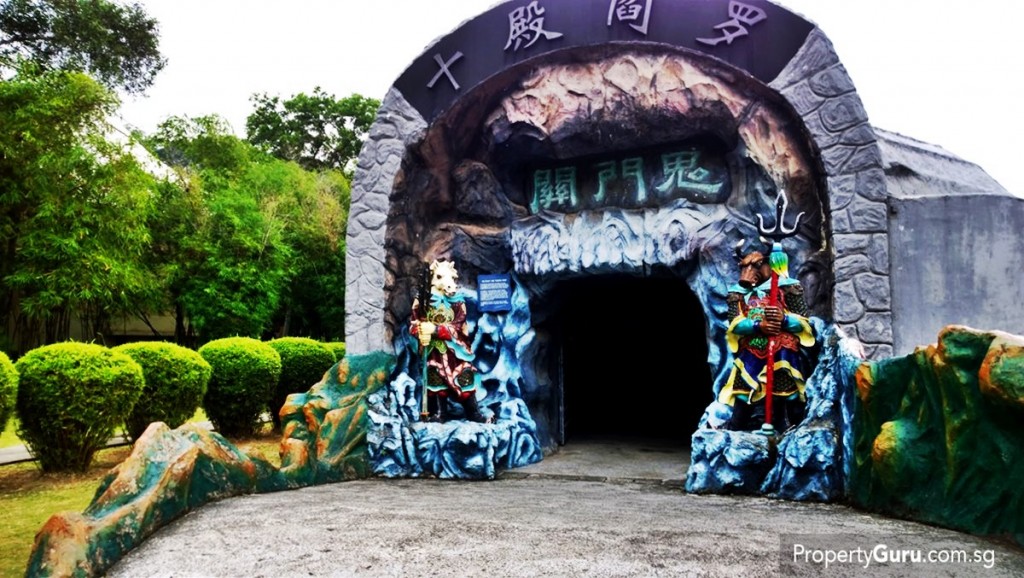There’s nothing quite like teaching morality and values by scaring the bejesus out of everyone. And there is nowhere else in Singapore (except perhaps in your own home) that does this better than Haw Par Villa.

In retrospect, the once terrifying images of hellish landscapes and damned souls caught in a fresco of immutable torment lacks a certain punch. Its old statues, ever lovingly maintained are too cartoony to inspire true terror in anyone above 15-years old, and the park with those colourful statues and dioramas appear positively tame and surreal under the relentlessly bright glare of the island’s scorching sun.
But come nightfall, when the park is closed to visitors and a dark pall settles over the land, the demons that keep watch over the fabled Ten Courts of Hell lose their Saturday Morning Cartoon vibe and transform under the waxing moon into silent gargoyles that guard the portal to a vast labyrinth – where the pitfalls of sin are laid bare in full and frightening detail.
In many ways, the lessons baked into the fabric of Haw Par Villa teems at the same frequency with how Asian parents would discipline their children. The element of fear and the fear of punishment for a lapse in moral behaviour is ever present.
And in 1937, the Brothers Aw thought this to be a sound premise for a theme park.
Originally known as Tiger Balm Gardens, the park was built by Aw Boon Haw as thanks to his brother Boon Par for helping to market their medicated ointment, Tiger Balm. This magnanimous gesture had a secondary purpose as the park served not just as a residence for Boon Par but also as a site where Chinese culture may be remembered.
Statues of the Eight Immortals and Journey to The West kept watch alongside the mermaids, dragons, water nymphs, tigers and of course, the demons. The life-sized statues were unique and evocative. Their horrifying visuals entertained and scarred a generation into always obeying their parents for fear of suffering as the statues do in the afterlife.
But no matter how terrifying those demons were, they paled in comparison to the real demons that came to the island’s shores in 1942; the Imperial Army.
The Brothers Aw would split up – Boon Par to Burma (now Myanmar) and Boon Haw to Hong Kong – to escape the invasion. During those dark times, Tiger Balm Gardens would, like all other places in Singapore, come under the purview of the Imperial Army. The park was used as an outpost for the Japanese due to its high vantage point that provided an unhindered view of the coast and of the ships at sea.
Boon Par passed away in 1944, a year before the Japanese surrendered. With Singapore in a state of rebuilding after the war, Boon Haw would return to the struggling nation to repair the damage afflicted to the park and bequeath it as a gift to his brother’s son, as he had so done for his brother in 1937.
The Aw family would run the park until 1979 when they handed it over to the Singapore Tourist Promotion Board. But it wasn’t until 1986, during the tenure of International Theme Parks, when Tiger Balm Gardens was given an $80 million facelift, including an expansion by five times to the park grounds.
International Theme Parks renamed the park to Haw Par Villa, in honor of the Brothers Aw.
The park was officially opened in 1990 but with a costly admission fee of $16.50. By 1998, the park suffered losses of up to $31.5 million. When the Singapore Tourism Board reclaimed the park in 2001, the rides were removed and the park returned to its simpler and inexpensive version.
Like hell in every religion, Haw Par Villa is now open to everyone. Unlike every hell, no sin needed to be committed to enter its grounds. The park’s ghastly depictions of the underworld attracted some 200,000 people annually – a far cry from the millions it used to draw during the 70s and 80s. It was a modest amount for a park far more iconic and synonymous to Singapore’s early history than all the Sentosas and Marina Bay Sands put together.
Over the years, brief plans to reinvigorate the park had middling success only for each venture to ultimately fail. In 2015, the STB appointed a new park manager – tour operator Journeys – to breathe new life into Haw Par Villa.
Since then, plans were put in motion to refurbish it and modern contrivances like gift shops, dining outlets and assorted retail elements are in the works. Journeys also have plans to hold various events such as art exhibitions, performances, flea markets and even yoga, taiji and wushu sessions in an effort to preserve the park’s original intent as a bastion of Chinese culture.
Whether Haw Par Villa ever reaches a crescendo of visitors seen in its heyday is a question no one has the answer to. But its proximity to Alexandra and Queenstown – which are seeing much gentrification and the upcoming Greater Waterfront City at the old terminals – dangles the promise of more people in the future.
Haw Par Villa may very well see a resurgence in popularity but it may be some time before it regains that popularity. For the moment though, the tigers and demons aren’t going anywhere.





